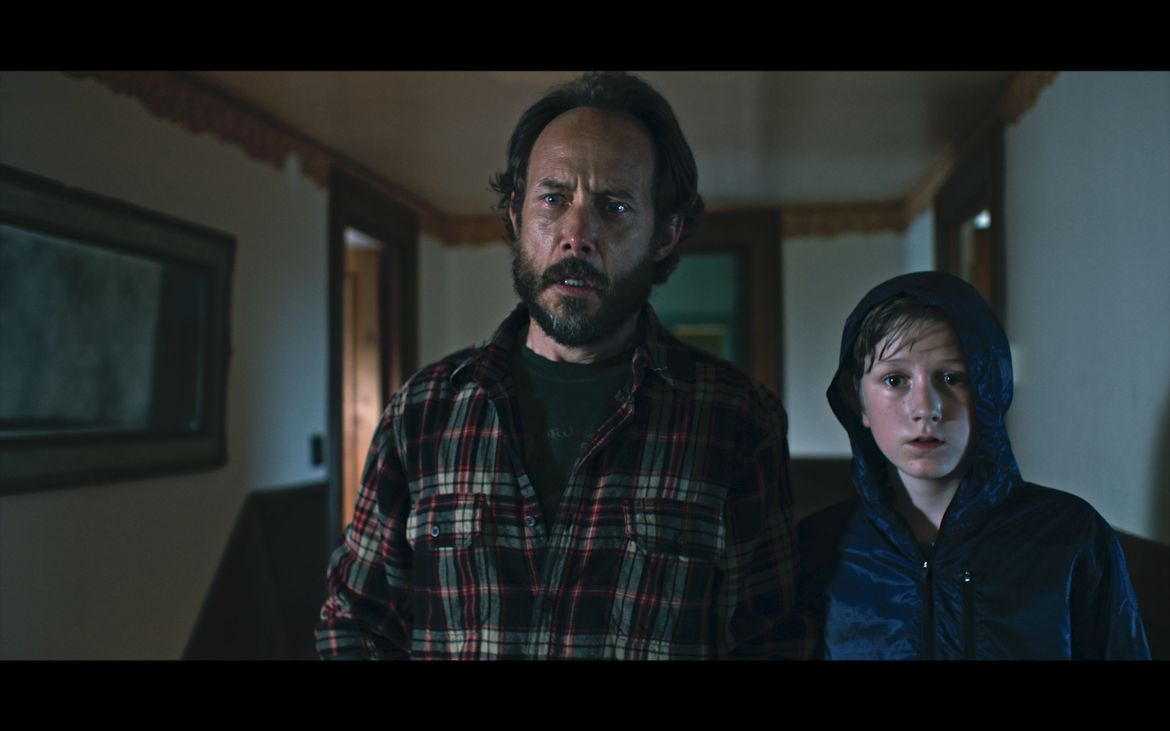With the rise of so-called “prestige horror” and the mainstream establishment beginning (yet again) to take the genre seriously, contemporary horror films have the unenviable task of measuring up to a multitude of competitors for audience attention. But the increased emphasis on horror as a viable mainstream genre also means there’s plenty of space for different types of horror in the cinematic landscape. So it’s nice to see small, subtle scary stories standing up in spaces that have been increasingly occupied by “serious” horror films like Hereditary or The Babadook. Writer/director Andy Mitton’s The Witch in the Window is unlikely to become the next big sleeper hit, but then it doesn’t aspire to be – it aspires to tell a good scary story.
The Witch in the Window takes the trope of the dysfunctional family as its starting point. Simon (Alex Draper) is an absentee father who spends most of his time fixing up and flipping houses. When his son Finn (Charlie Tacker) gets into trouble for breaking the parental locks on his computer, Simon agrees to take the boy out of the city and up Vermont for the summer, to work on a new house. But the house comes with a dark history—its previous owner Lydia (Carol Stanzione) died sitting in its big front window, and locals believe that her spirit haunts the property, gaining strength and purpose as the house is repaired.
The Witch in the Window at times feels like an updated Stephen King short story, trading on horror tropes and haunted houses as spaces where repressed anger and family dysfunction plays out. It’s all here: local legends (related by folksy townspeople), a creepy curse, dark secrets, confused and hidden motives. The horror lies not so much in what happens, but in the dread of what can happen, the bumps in the night, the flickering of lights, and, yes, the witch in the window. And the film presents these elements in a fairly straightforward way—there are few revelations, merely the slow unraveling of a scary story in a haunted house.

If much of horror is the return of the repressed, The Witch in the Window’s central antagonist makes for an interesting, if not always coherent, monster, a mother who has lost her family and may or may not be bringing another one back together. Simon and Finn learn Lydia’s story through their neighbor/electrician Louis (Greg Naughton), who grew up in the area and believes that the house, and more specifically the woman who died in it, was somehow a bad one. But it’s not clear if Louis is trustworthy, and there are times when Lydia seems like both an evil and a benevolent presence, attempting to hold Finn and Simon for some purpose of her own.
The film reveals issues within Simon and Finn’s relationship, and Simon’s feelings towards his estranged wife Beverly (Arija Bareikis). Finn’s transgressions on the internet are more complex than just a twelve-year-old looking at porn, and Simon’s complex reasons for his absenteeism come into focus as the pair grow closer and the house becomes stronger. The reparation of the house is intended to repair the family, but the repairs also make Lydia stronger, creating a triangle of need in which the strengthening of the relationships come at a cost.
Unlike many contemporary horror films, which seem to forget the existence of the internet, cell phones, and viral video, The Witch in the Window relies on modern technology without it becoming the central concern. In the background are Finn’s “transgressions” that have his mother insisting he leave the city (and the internet) behind, and which become a factor in his bonding with his father. But there is a double-edge to everything—increased connections and connectivity via technology go hand-in-hand with emotional distance and the nebulous nature of what can be seen and what should be seen. Lydia should not be seen, Finn sees much that he shouldn’t, and Simon must navigate what that means for himself and the future of his family.
The Witch in the Window follows the visual austerity of bigger productions like The Conjuring, making copious use of greys and blues (although it happens in the summer). It’s far from a visually striking film, though there are several moments of tension made stronger by the unwavering camera eye, and it’s this economy of imagery that prevents it from being considered “prestige” horror. But that’s just fine by me—we have to make space for movies like The Witch in the Window without requiring them to fall into categories more acceptable to a mainstream criticism that wants to reject genre as lowbrow (except when it’s not).
The Witch in the Window won’t have the staying power of some other indie horrors. It’s too small and slight, in narrative, theme, and technique, to be more than that. But then, it doesn’t try to be. It’s a scary story, well-constructed and delivered with an economy of spirit and imagery that is somewhat refreshing after the thematically overburdened narratives to which we’ve grown accustomed. Will it scare you? Maybe. It will certainly entertain.
The Witch in the Window shows at Fantasia 2018 on July 23 and 27.

Episode 44: Dame – Impossible – Citizen Dame
[…] The Witch in the Window […]